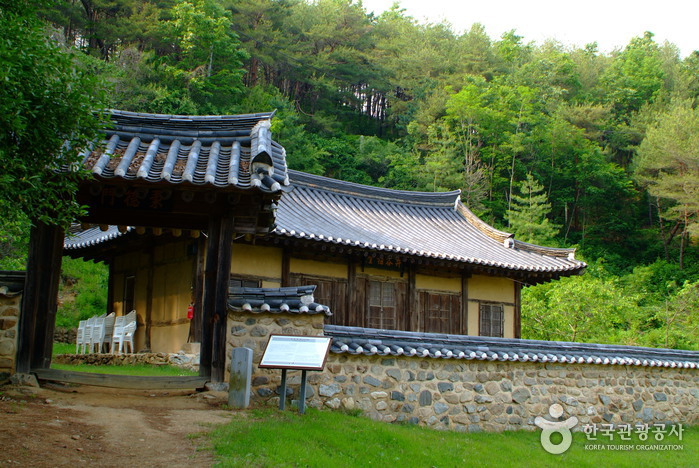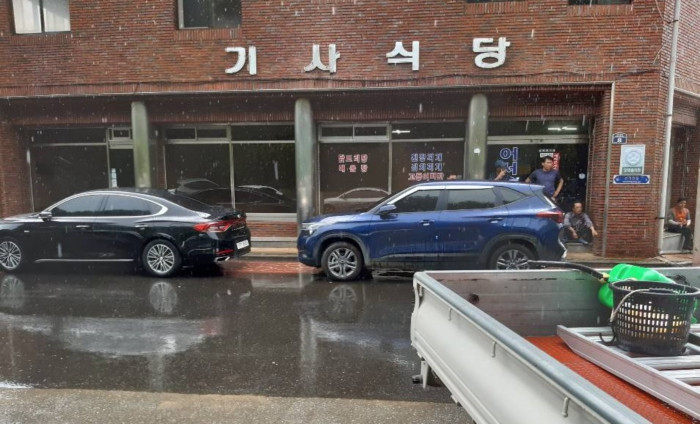Aldea de las Artes Jirye (지례예술촌)
.0M 2024-05-07
Jiryeyesulchon-gil 427, Imdong-myeon, Andong-si, Gyeongsangbuk-do.
La aldea se creó con la construcción de la Presa Imha de Andong. En el año 1986, el área de Jirye-ri, Imdong-myeon, de la ciudad de Andong, se encontraba en peligro de hundimiento, por lo tanto, el actual jefe de la Aldea de las Artes Jirye, Kim Won-gil, había trasladado la pequeña aldea hacia un sitio más seguro, detrás de una montaña, instalando 10 edificios. Luego en el año 1990, el Ministerio de Cultura lo había designado como la Aldea de Creatividad Artística, por lo que hasta el momento es utilizada como un espacio de entrenamiento para los trabajos de los artistas. Hay muchas presas multifuncionales construidas en el país, pero esta fue la primera que gracias a la idea de una persona, se ha podido preservar el patrimonio cultural y también establecerlo como un espacio artístico.
Posee un paisaje natural maravilloso, ya que por la noche el cielo es bordado de estrellas y hasta también pasean volando las luciérnagas. Lo único que se escucha, son los cantos de los insectos y el soplo del viento, y, por las mañanas, el lago se viste de la niebla húmeda, por lo que presenta otro escenario mágico y misterioso. El paisaje natural se viste de distintos colores, según cada estación, primavera, verano, otoño e invierno. Visitando la aldea, tendrá la posibilidad de experimentar de aquellas actividades básicas de la vida, recolectar verduras, frutas y setas de pino, cazar peces, y, también degustar de los platos típicos de la región de Andong. En particular, la otra gran experiencia, es que tendrá la oportunidad única de alojarse en la habitación con ondol (sistema de calefacción tradicional), dentro de una construcción de madera que posee 350 años de antigüedad, la que también fue declarada como material patrimonial por la provincia de Gyeongsangbuk-do. Todos los detalles de la casa, será motivo suficiente para que pueda disfrutar del ambiente.
Aunque el papel principal de la aldea es ser utilizada como un espacio de trabajo para los artistas, también es famoso para los turistas extranjeros, que lo frecuentan para conocer y experimentar la cultura coreana. El sistema de baño que utiliza la energía solar, y por la instalación de internet, ha facilitado el acceso de las mujeres y de los turistas extranjeros. Cada año es visitado por más de 5.000 personas.
Jeongjae Head House [Korea Quality] / 정재종택 [한국관광 품질인증]
6.3Km 2023-04-13
경상북도 안동시 임동면 경동로 2661-8
+82-10-8590-0625
Boasting more than 300 years of tradition, Jeongjae Traditional House is the head house of Ryu Chi-myeong (pen-name: Jeongjae), who inherited the study of Togye Yi Hwang (1501-1570), one of the two most prominent Korean Confucian scholars of Joseon. The old house features the characteristic construction elements of a Joseon hanok, including the stylobate, wooden pillars, toenmaru (the narrow wooden porch running along the outside of the building), tiled roof, and other structures, and commands an open view of Imha Lake. The house was originally built by Ryu Gwan-hyeon, the great-great-grandfather of Ryu Chi-myeong, in 1735 (the 11th year of the reign of King Yeongjo of Joseon) in the village of Handeul in Imdong-myeon, Andong-si, Gyeongsangbuk-do, but it was relocated to the foot of Guamsan Mountain in 1987 when Imha Dam was built and the surrounding area was submerged as a result. The house consists of the daemunchae (gate building), jeongchim (a ‘ㅁ’-shaped house with a tiled roof), haengnangchae (servants’ quarters), a shrine, and a pavilion. The sarangchae (men’s quarters) is clearly visible, while the anchae (women’s quarters) is concealed within the house. The sarangchae has a sarangmaru (wooden floor), a large sarangbang room, a small sarangbang room, and there is a small maru between the two rooms. The buildings of the sarangchae and anchae are clearly divided into segregated spaces for men and women according to Confucian tradition. The anchae has a daecheongmaru (large wooden floor) in the middle; a main room, kitchen, and toilet on the right; and a numaru (upper floor) and sangbang (upper room) on the left. The small side door of the main gate links to the door by which to enter the anchae, which has a small vegetable garden. Manujeong Pavilion (Gyeongsangbuk-do Cultural Heritage Material No. 37) is a half-hipped roof building with single-layered eaves located on the left side of the house outside the main gate. It is the place where Ryu Chi-myeong used to teach his students, and consists of a large maru and a guest room. The pavilion is also surrounded by the beautiful scenery of Imha Lake, mountains, and chestnut trees. Jeongjae Traditional House provides two special experience programs: Making Songhwaju, which is the Ryu family’s home-brewed liquor (15 to 18 degrees) made with rice, glutinous rice, yeast, pine needles, and chrysanthemums, led by the owner’s wife (Intangible Cultural Asset No. 20); and Making Tarak, which is a fermented milk drink that has been made by the Ryu’s family for some 500 years. As the recipe for making Tarak is relatively simple, and uses yeast that is usually used to make raw rice wine like Makgeolli, people can easily make it at home. The house also runs a traditional music program designed to show participants how to play the gayageum (Korean zither with twelve strings) and sing Korean folk songs, and stages small concerts.
Imhaho Gisa Sikdang(임하호기사님식당)
6.9Km 2021-04-09
8, Seonchakjang-gil, Andong-si, Gyeongsangbuk-do
+82-54-822-4929
There are a variety of side dishes, so you can enjoy different foods. This Korean dishes restaurant is located in Andong-si, Gyeongsangbuk-do. The representative menu is kimchi stew.
Song jeong Historic House [Korea Quality] / 송정고택 [한국관광 품질인증]
10.6Km 2020-09-10
15-1, Songsogotaek-gil Pacheon-myeon, Cheongsong-gun, Gyeongsangbuk-do
+82-10-8746-6690
Cheongsong-gun in Gyeongsangbuk-do is a small village blessed with a spring flowing with natural mineral water, a beautiful valley with a majestic waterfall, and a mountain densely covered with pine trees. Thanks to this superb natural environment, Cheongsong-gun was designated as a 'Slow City' in 2011. Songjeong gotaek (The Old House of Songjeong) is located in the village of Deokcheon in Cheongsong-gun, which is one of the three richest and most prestigious families in the region.
These three wealthy families are said to have produced millionaires for nine generations - from Sim Cheon-dae during the reign of King Yeongjo of Joseon (r. 17224-1776) to the 1960s. In particular, it was a seventh-generation grandson, Sim Ho-taek (pen-name: Songso), famous as one of the richest men in Joseon, who built Songso gotaek (Old House of Songso) along with three houses for his three sons, including Songjeong gotaek for his second son Sim Sang-gwang (pen-name: Songjeong) around 1880. As the Cheongsong Sim Clan has lived in the area for many generations, Cheongsong is known as the village of the Cheongsong Sim family.
Covering a total area of about 10,000m2, Songjeong gotaek has a tall and grand front gate that symbolizes the wealth of the family. Upon entering by the gate, the large outer courtyard comes into view, followed by a gate connecting to the Old House of Songso on the right, and a walking path connecting to a well and a pine grove on the left. The square-shaped structure consists of a sarangchae (detached building), chaekbang (library), and daecheongmaru (main floored room). Passing through the entrance, there are the main building and the inner courtyard. Notably, the chaekbang has retained its original appearance from the time when it was used by Sim Sang-gwang.
Although the house is very large, its interior is simply and modestly designed according to the virtues favored by classical scholars. The rooms are floor-heated in the traditional way (by ondol) using wood, decorated with traditional hanji (Korean paper), and equipped with traditional bedding.
Songjeong gotaek offers visitors a variety of experience programs designed to promote the form of Korean classical music known as Gukak. It holds three major musical events each year including a pansori folksong program and a fusion gukak concert, attracting an audience of anywhere from 200 to 800 people to the courtyard of the house. Sometimes, families hold parties to celebrate their parents’ 60th, 70th, and 80th birthdays.
The low hill situated behind the house has a quiet walking path.
Cheong won dang [Korea Quality] / 청원고택 [한국관광 품질인증]
10.7Km 2021-04-05
3 Songsogotaek-gil, Pacheon-myeon, Cheongsong-gun, Gyeongsangbuk-do
+82-10-3530-6119 / +82-54-872-6119
Under joint management with the Korean Tea Association’s Yeongeun Culture Center, Chungwon Gotaek is a great place to enjoy traditional Korean tea time while experiencing a traditional Korean house where you will see all the features of an old Korean house as well as how people lived a slow and leisurely life in the past. Since Chungwon Gotaek only has one stand-alone guestroom that can be booked by only one couple/group at a time, it’s the perfect place to stay for leisure. The guesthouse has a separate tea room managed by the Yeongeun Culture Center, where you can enjoy traditional Korean tea while learning the proper way to drink tea in Korea, which is quite different from that of other Asian countries. Many Korean guests will agree that they feel at home. The guesthouse also serves Korean-style breakfast, which includes various side dishes that vary by season.

![Jeongjae Head House [Korea Quality] / 정재종택 [한국관광 품질인증]](http://tong.visitkorea.or.kr/cms/resource/96/2579496_image2_1.jpg)

![Song jeong Historic House [Korea Quality] / 송정고택 [한국관광 품질인증]](http://tong.visitkorea.or.kr/cms/resource/75/2573875_image2_1.jpg)
![Cheong won dang [Korea Quality] / 청원고택 [한국관광 품질인증]](http://tong.visitkorea.or.kr/cms/resource/32/2528932_image2_1.jpg)
 Español
Español
 한국어
한국어 English
English 日本語
日本語 中文(简体)
中文(简体) Deutsch
Deutsch Français
Français Русский
Русский